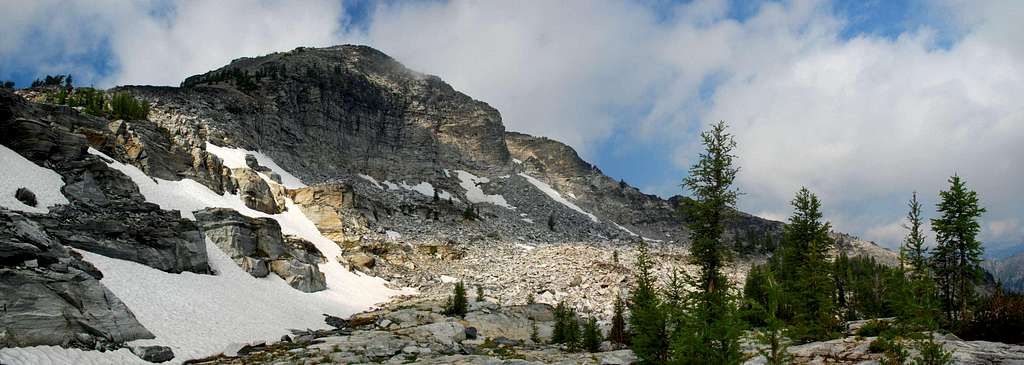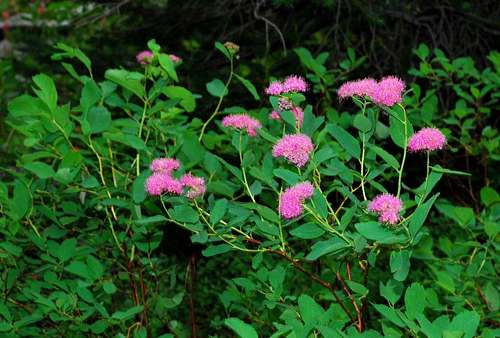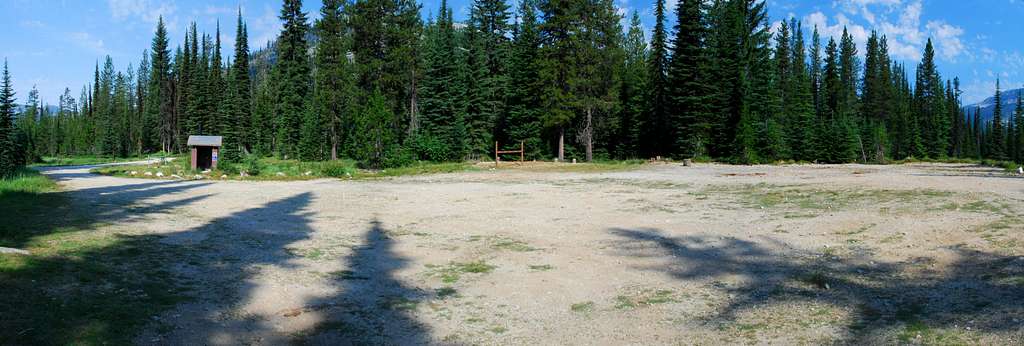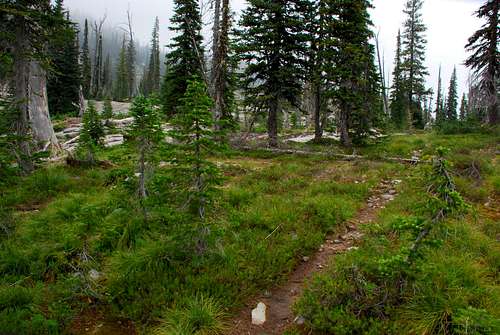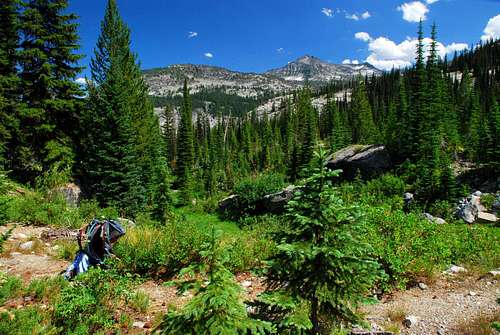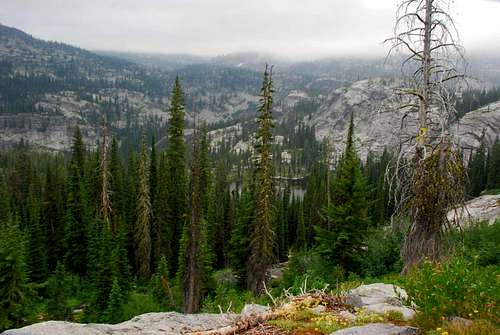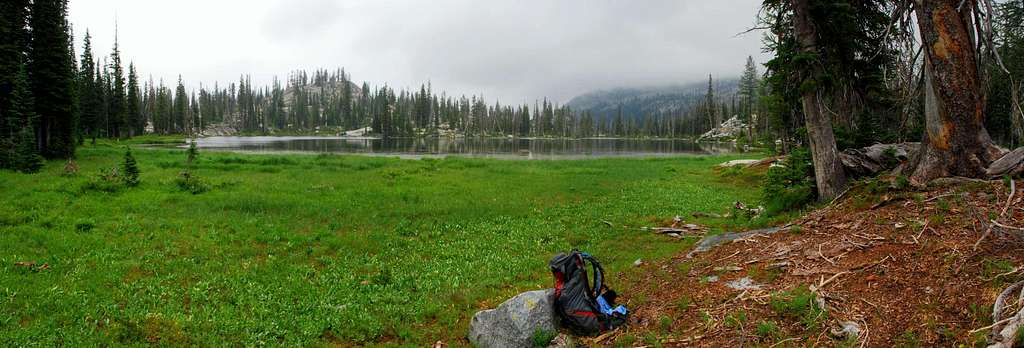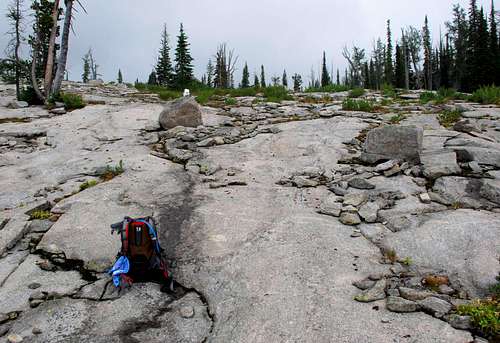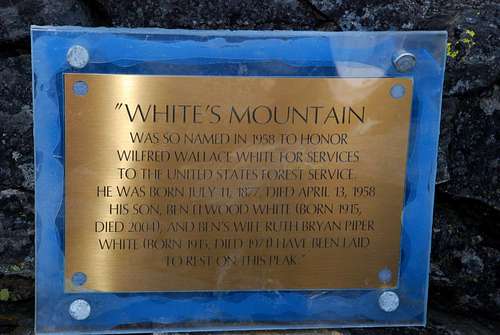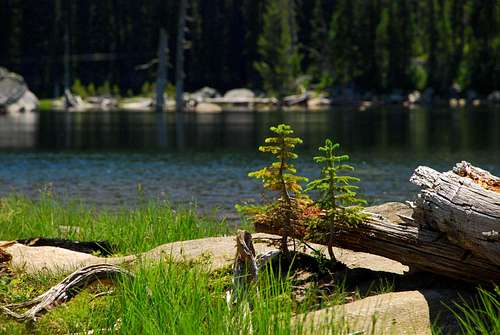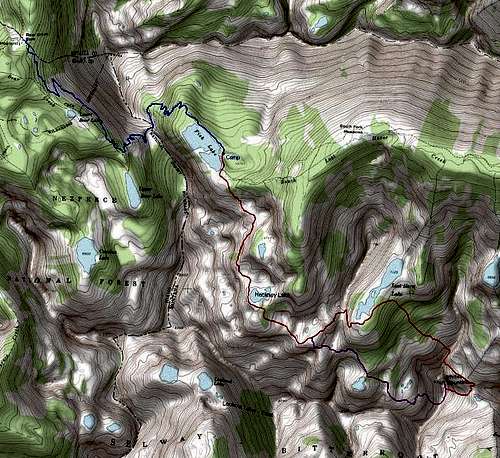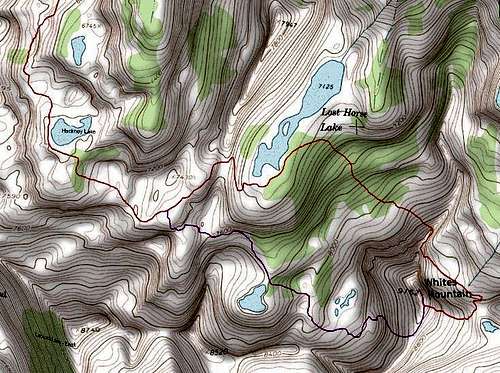-
 4949 Hits
4949 Hits
-
 78.27% Score
78.27% Score
-
 9 Votes
9 Votes
|
|
Route |
|---|---|
|
|
46.07316°N / 114.4124°W |
|
|
Hiking, Mountaineering, Scrambling |
|
|
Summer, Fall |
|
|
Most of a day |
|
|
Strenuous |
|
|
Class 3 |
|
|
I |
|
|
Overview
Route Type - Scramble Class Level – Class 3 Elevation – 9,162’ Gain - 3,150' Distance - 4.5 miles (one way from Fish Lake) Length of time required to complete route – one day It’s a long way from anywhere to the summit of Whites Mountain. It makes sense to hike in part way and set up a base camp from which you then climb the peak. I approached from Fish Lake which can be reached on a mostly-nice trail from the Bear Creek Pass Trailhead. By continuing past Fish Lake and camping at Hackney Lake the climbing portion of this route can be shortened considerably.
Whites Mountain is located between the Rock Creek Drainage (to the south) and the Lost Horse Drainage (to the north). It’s way back in the Bitterroots, on the Montana side of the state line, though some consider the best access to be from Idaho. Because of its remoteness, this peak is seldom climbed. When I reached the summit on July 19, 2007, it was obvious (from the little-worn track near the summit) that I was one of a limited number who had made the effort to reach the summit. In a way it’s too bad more don’t visit this highpoint in the midst of pristine wilderness. The peak was named in 1958 for Forest Supervisor, Wilfred Wallace White (born July 11, 1877, died April 13, 1958). A plaque on the summit states that the remains of Wifred’s son, Ben, and his daughter-in-law (Ben's wife), Ruth, have been laid to rest on the mountain. Getting ThereBear Creek Pass Trailhead Drive south from Hamilton, MT on Highway 93 for a little over 9 miles. Turn right (west) onto Lost Horse Creek Road. Drive almost 18 miles to the Lost Horse Guard Station where the road forks. Stay left, following the sign for Bear Creek Pass. (The right fork will take you to Twin Lakes). Drive another 1.2 miles to the camping and parking areas – camping to the right, parking to the left. There is an outhouse available along with facilities for loading and unloading stock animals. The trail is south-southeast of the outhouse and not easily visible until you’re close. It is marked with Forest Service signs. Route DescriptionThe Approach - Trailhead to Fish LakeFrom the Fish Lake Trailhead, hike south-southwest along the well-defined track. The trail to Fish Lake has been re-engineered fairly recently and is now in pretty good shape. With switchbacks at the appropriate places, the going is comparatively easy. About a mile from the trailhead, the track traverses along the southwest side of Point 8164. Reaching 1.8 miles, it begins climbing northeast toward Bear Creek Pass (46.10431 N / 114.46633 W, elevation of 7,200’). From the pass, the trail contours along the southeast side of Point 8164, remaining quite level, until at a point just under 3 miles from the trailhead, it begins descending to Fish Lake. As you reach 4 miles from the trailhead, you find yourself beside the lake, elevation 6,700’. Note: The winter of 2006-2007 placed some monster deadfall on the trail between Bear Creek Pass and Fish Lake. It's not impassible, but this section of trail takes more effort than it should. I will mention that over the last few years, the Bear Creek Pass Trail has been extensively re-engineered. If it wasn't for the deadfall, it would be one of the best trails in the Bitterroots. There is a well-established camp site along the eastern side of the lake about three quarters of the way to the dam. It’s on a slight knoll and just uphill from the only sandy beach on the lake. This is where I established base camp. Climbers’ Route - Fish Lake to Summit There is a well-established track between Fish and Lost Horse Lakes. It may be possible to pick a better line between the two, but using the trail eliminates bushwhacking which would certainly require more time and energy. From Fish Lake follow the track south-southeast from the dam at the southern end of the lake. It crosses a few small wet meadow before heading uphill into the woods. Note: Do not turn east onto the Lost Horse Creek Trail. If you find yourself walking along the Fish Lake outlet stream, you are on the wrong trail. Backtrack and find the trail leading southward. Switching back uphill through the woods, the track eventually enters a more open area and crosses granite slabs interspersed with small grouping of trees. The track is faint over the slabs, but is well-marked with cairns. One mile from Fish Lake, the trail begins traversing along the eastern slopes of a ridge. There is more plant growth in this area but the trail is very well defined. If you look to your left (east) and down-slope, you will see a small unnamed lake. At 1.6 miles, after crossing another area of slabs, you will reach Hackney Lake. Note: I believe the area around Hackney Lake is a much better place to establish a base camp than at Fish Lake. There is a small rise on the north side of the lake which has several places to set a tent. Not only is this lake closer to your destination, White’s Mountain, but the camping is likely to be less buggy than at Fish Lake. Follow the track around the west end of the lake. Where the trail crosses a boggy area, it disappears for a bit. No matter, it’s quite easy to find on the other (south) side of the bog. After passing the lake, the track turns east then south as it enters another section of fairly thick woods. At about 2 miles and before exiting the woods, the trail turn east-southeast as it continues to climb. Turning southeast the trail again crosses areas or slabs. Be sure to follow the cairns or you could lose the trail. At about 2.3 miles the trail reaches its highpoint (7,400’) then performs a slight descent before turning northeast over a fairly large grassy meadow. When you finish the short descent and reach the edge of the meadow (45.07722 N / 114.43498 W), look to your right (south) for a slight depression (not exactly a saddle) on the ridge. Leave the existing track and head up to the depression. Once you’re on the ridge, travel over slabs and through open forest in an easterly direction. When you’ve gone about .5 mile after leaving the trail, turn to your right (southeast) and work your way uphill in the obvious draw. Just before you reach the small unnamed lake, turn slightly east and climb uphill, aiming for a spot between two slight bumps and directly toward the White’s Mountain summit, which you should see quite clearly (weather permitting). After passing between the two bumps, you will have a clear view of White’s Mountain and its southwest ridge. You will note several cliff bands guarding the ridge-crest. Fortunately, they do not extend all the way across the ridge and they have weaknesses which can be exploited. There is unlikely to be a “perfect” track from your position up to the ridge-crest, so make your best judgment, and pick a line. During descent of this route, I stayed too far to the north (your left, as you stand below, facing the ridge) and had to use some artful-dodging around cliff bands. In retrospect (and after studying the picture from below the ridge) I suspect the best routes to the ridge-crest will be up the center (just left of the most prominent cliff bands). With careful route finding, you should be able to keep your climbing at Class 3. Once you reach the ridge-crest head north toward the summit. By staying to the right (east) of the rock outcroppings, the remainder of the climb is Class 2. Essential GearUnless you’re a fitness god, backpacking to establish a base camp will be required for climbing White’s Mountain. For the climb, you will need sturdy hiking boots and gear appropriate for the current weather conditions. There is little exposure while climbing the southwest ridge. Depending upon the route you pick, you’re unlikely to exceed Class 3 climbing. When to GoThis peak is almost unreachable during snow conditions unless you’re willing to ski or snowshoe a long way. Lost Horse Road is closed during winter and sometimes doesn’t open until late June – portions of it are often washed out during the spring melt. It is possible to reach White’s Mountain from the Rock Creek Trail, even during winter. But it’s a much longer hike (snowshoe or ski in winter) and bushwhacking through dense forest is required. So, I suggest climbing this peak during the summer or fall (before the snow flies). Route Statistics
|


